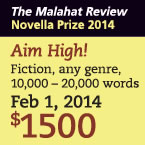 Deadline: February 1, 2014 (postmarked)
Deadline: February 1, 2014 (postmarked)
Prize: One $1,500 CAD prize will be awarded
Entry fee:
$35 CAD for Canadian entries
$40 US for entries from the USA
$45 US for entries from elsewhere
$15 CAD for each additional entry
(entry fee includes a one-year subscription to The Malahat Review)
Enter a single work of fiction, with a minimum length of 10,000 words and maximum length 20,000 words.
Read full guidelines on our website.

The Focus of the Novel: Molly McFaul in Conversation with Ann Ireland
MM: The novella is a very specific form. How is it different from a short story, or a novel? What are the difficulties inherent to this specific form? Is there a uniqueness that affords aspects of this form to be unlike any other?
AI: A novella has a unity of form, and doesn’t go off on tangents and subplots. Usually. Any writer should feel free to upend this statement. It can feel like it’s been written in one very long breath, one arc of consciousness. I love the form because it’s longer than a story (unless you are Alice Munro and your stories are like novellas) and thus it has time to worm into the brain. Long enough for the reader to inhabit a world but not get tired of it. The pleasure is in the sharp focus. I think of Margarite Duras’s “The Lover,” or early Ian MacEwan novellas. Slim Ondaatje books such as Coming Through Slaughter and Billy the Kid are my favourite of his fictions.
Read the rest of Ann's interview on our website.

Under the Publicity Spotlight: Heike Lettrari in Conversation with Greg Hollingshead
HL: It’s not too late to offer a few shining words of wisdom or encouragement for writers submitting work to the Malahat’s 2014 Novella Prize, so from your experience as both a writer and an instructor of writing, are there any tips you’d recommend to those intending to submit?
GH: Remember that you need to still love it when you send it out. If you don't, there's a good chance your reader won't. So hold out for sending out something you love and that has continued to surprise you. And don't worry about too strange. Great always seems strange at first, even to the one who made it.
Read the rest of Greg's interview on our website.
 The Character as Attribute: Samantha Ainsworth in Conversation with Pauline Holdstock
The Character as Attribute: Samantha Ainsworth in Conversation with Pauline Holdstock
SA: Your latest novel, Into the Heart of the Country (long-listed for the 2012 Giller Prize) focuses on the integral role and sacrifices of native women during the 18th-century Canadian fur trade. You have created a vehicle through which these essential women are brought into our midst, into our world of iPads, microwaves, and fast food. How did you come to unearth these vital women, and their stories buried with them? And what drove you tell their tale?
PH: Every period of history has its official, received account, a version riding over top of the untold stories that you find if you rake around in in history’s footnotes. For me the footnotes and the margins also merit attention, and can be used to highlight neglected episodes of the received version. In Samuel Hearne’s letters, I found a sentence that kindled some of the ideas I was playing with. When he returned to Prince of Wales Fort after surrendering it to the French, he wrote, “…all the Indians that used to trade here are either dead with the small pox, starved to death last winter or removed so far into the heart of the country that it will be next summer at least before the few survivors hear of my arrival here.”
Read the rest of Pauline's interview on our website.

Writing as a Continuum of Fear: Alexandra Handley in Conversation with Liz Windhorst Harmer
AH: Contest judge John Vaillant said that your winning entry, “Blip,” “demonstrates a wonderful discipline and restraint.” I have to agree, and I wonder if it was difficult for you to construct such a contained narrative from your past experience?
LWH: In one way it was very difficult. About two years ago I abandoned the writing of a long memoir based on this experience. I had already written 100 pages and was learning all sorts of things about the experience, but I realized that the timing wasn't right for me to write this as a book. I happened at that point to be reading some essays by Jonathan Franzen. One of the essays, called "The Discomfort Zone," weaves biographical information about Charles Schultz into a narrative about Franzen's home life, and it inspired me to distill the long memoir I was working on into a shorter piece. So, “Blip” was distilled from quite a lot of work and time and energy and thinking.
Read the rest of Liz's interview on our website.